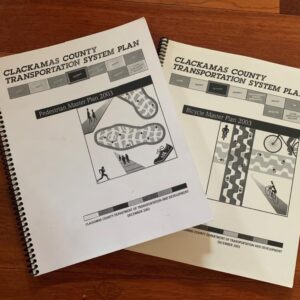[Publisher’s note: Our news intern, Patrick Croasdaile, happens to live in Clackamas County so he’s a bit closer to the action down there than I am. In the story below, he shares a roundup of Clackamas County bike news gleaned from a recent meeting of their biking and walking advisory committee.]

indicates the scope of the Clackamas
Regional Center Ped/Bike Connection Plan.
(Photos © P. Croasdaile/BikePortland)
The Clackamas County Bicycle and Pedestrian Advisory Committee (CCBPAC) held their second meeting of the year on Tuesday night. They covered a lot of ground. While the committee spent the majority of time reviewing the upcoming Clackamas Regional Center Pedestrian and Bicycle Connection Project, topics such as bicycle facility improvements on Highway 43, the Oregon City bridge shuttle, and the County’s application for an Oregon Scenic Bikeway all received considerable discussion. They even touched on Safe Routes to Schools.
First, we got an update on the proposed bike improvements to Hwy 43 we first told you about back in December.
Committee Chair Peter Goodkin and Clackamas County Planner, Scott Hoelscher, said the County was looking into “doing some re-striping, some sort of quick fix, to add bike facilities” on Hwy 43. Ideally, County officials want low cost bike lanes utilizing the existing right of way on the highway. Part of this process will involve the removal of overgrown vegetation to make room for improved bike facilities. Goodkin seemed concerned that progress on 43’s improvements might stall with the departure of County Chair Lynn Peterson. Hoelscher echoed this concern, saying that Peterson had been the project’s “guiding force” and had “initiated [efforts] looking at [Hwy] 43 for improvement.” Bike improvements on Hwy 43 are of great importance to the advisory committee, and they plan to do whatever it takes to see them through — even without Peterson on their side.
“The state’s gripe is, ‘well, we’re not going to be able to fully evaluate it because we can’t ride the whole route.'” This sentiment irritates some committee members, as it was a state organization that shut the bridge down in the first place.
On the matter of the Oregon City Bridge closure (see our coverage here), the committee felt there was still room for ODOT to improve the shuttle service. Chair Goodkin was concerned that there was not adequate signage to direct new users to the shuttle stops on either side of the river. Regarding efforts to bring bikes back to Oregon City, committee member Del Scharffenberg maintained that it would be hard to convince the region’s organized club rides to visit Oregon City because the shuttle’s limited size “makes it hard to do a round-trip.”
Related to the Oregon City Bridge closure is the County’s attempt to designate the Historic Canby Ferry Loop as an officially designated Oregon Scenic Bikeway. While the scenic bikeway designation would not go into effect for another two years, committee members were concerned that the bridge closure and shuttle provision might negatively affect the Canby Ferry Loop’s consideration (committee staff members Lori Mastrantonio-Meuser and Scott Hoelscher had just submitted an application to Oregon State Parks and Recreation prior to the committee meeting). Both discussed how the route’s attractiveness is diminished during the two year Arch Bridge closure.
It is, however, worth noting the recommendations included within the application. For instance, ODOT’s District 2A manager, Ron Kroop, wrote in his letter of recommendation that the proposed Canby Ferry Loop had ODOT’s “full support.” Mr. Kroop went on to write that “should this route be chosen [ODOT] will continue to offer support and/or input to the local proponent in the development of the Scenic Bikeway Management Plan.”
Ideally, support from the state organization that closed the Arch Bridge for improvement — ODOT — will mitigate concerns stemming from Parks and Recreation that the Canby Ferry Loop is not currently suited for scenic bikeway designation. As Mr. Hoelscher said, “the state’s gripe is, ‘well, we’re not going to be able to fully evaluate it because we can’t ride the whole route.'” This sentiment irritates some committee members, as it was a state organization that shut the bridge down in the first place.

a problem area as Sunnyside crosses I-205.
The majority of the meeting was spent discussing needed improvements to biking and walking access to the Clackamas Town Center. The County has received $80,000 to investigate barriers to walking and biking in the area surrounding Clackamas Town Center as part of its CRC Pedestrian and Bicycle Connection Project. On March 8th, county officials and representatives from ODOT will be making a visit to the designated site-area to identify biking and walking facilities in need of improvement. The survey will include observations of both county and state facilities. Committee members offered various suggestions ranging from the lack of adequate bike parking in the area to the dangers of riding on Sunnyside as it crosses over I-205 near the Clackamas Town Center.
At the end of the meeting, committee members answered questions about Clackamas County’s approach for Safe Routes to Schools (SRTS). In the light of impending cuts to school busing across the state, SRTS programs will ideally play a much more important role as a sustainable and cost-effective option. For the moment, Clackamas is significantly behind the SRTS efforts of neighboring Multnomah County.
Mastrantonio-Meuser said they had just applied for a SRTS grant for Sunnyside Elementary School, and intended to use progress made there as a template for SRTS programs elsewhere in the county. Unfortunately, however, there is not much in the way of grassroots movements across the county to support the creation of additional SRTS programs. Committee member Guenther explained that this was in part due to parent backlash from around the county amidst fears that biking and walking to school were not safe options for young children.
The Committee will meet again in the next two months. Stay tuned for updates on these and other topics from Clackamas County. If you’d like to know more about riding and walking in Clackamas County visit the new Connecting Clackamas website.





Appreciate your coverage of this! For additional resources re: biking in Clackamas County, cyclists will find good routes here (http://www.mthoodterritory.com/biking.jsp).
Thank you for this article, and keep them coming! I live in Gladstone, where bicycles are still largely regarded as the same as UFO’s!
Great to see some attention being paid to Clackamas County cycling, I hope the improvements I have seen will continue. I would love to see shoulders or bike lanes on Hwy 213 between Molalla and Mulino. Currently no shoulder, deep ditches on either side of the road, and too much car commuter traffic to make taking the lane a reasonable option. No efficient work around routes either.
Thanks for the update – I was unable to attend the meeting this month due to another commitment. Glad to hear they’re working on CTC improvements.